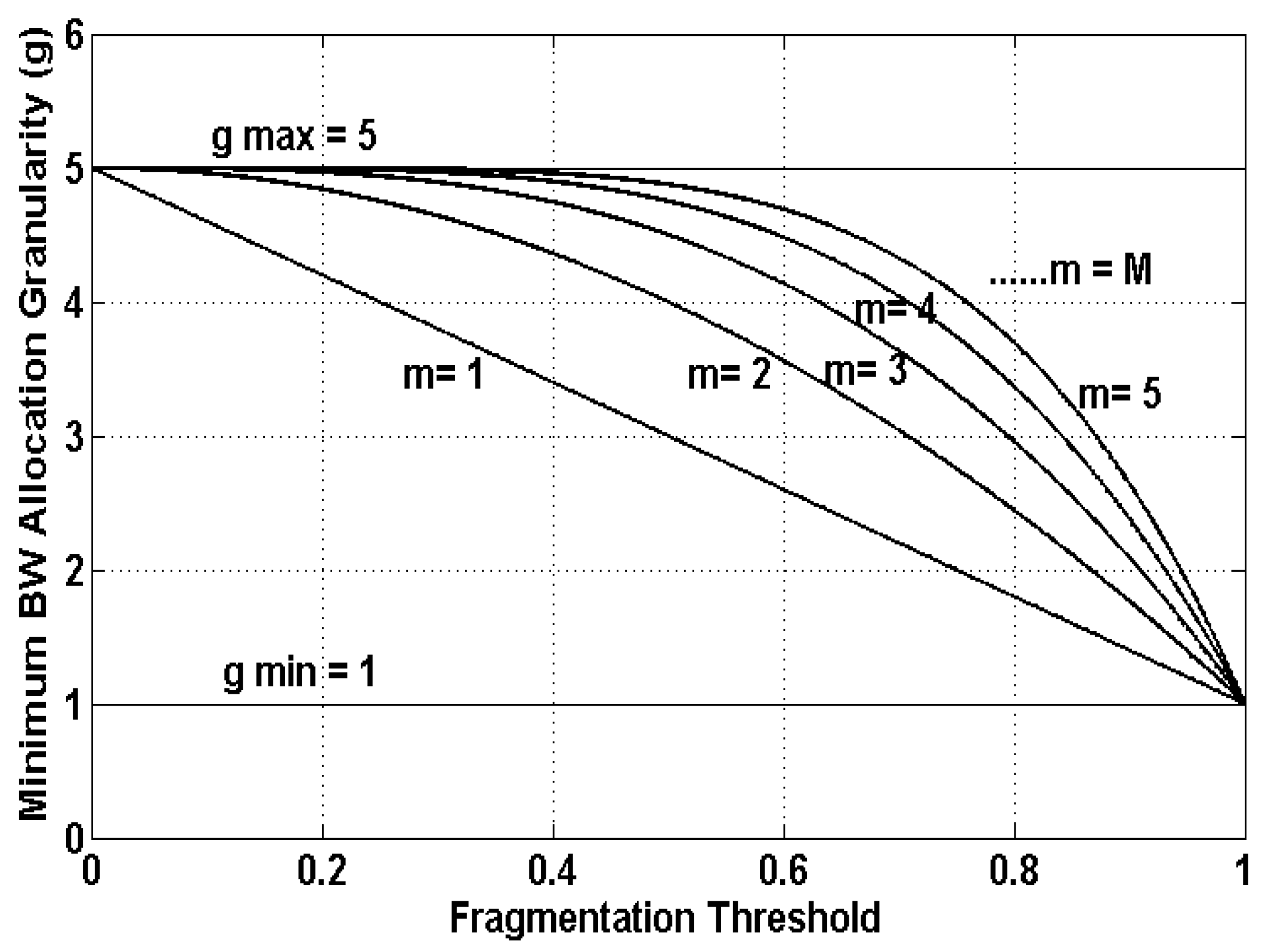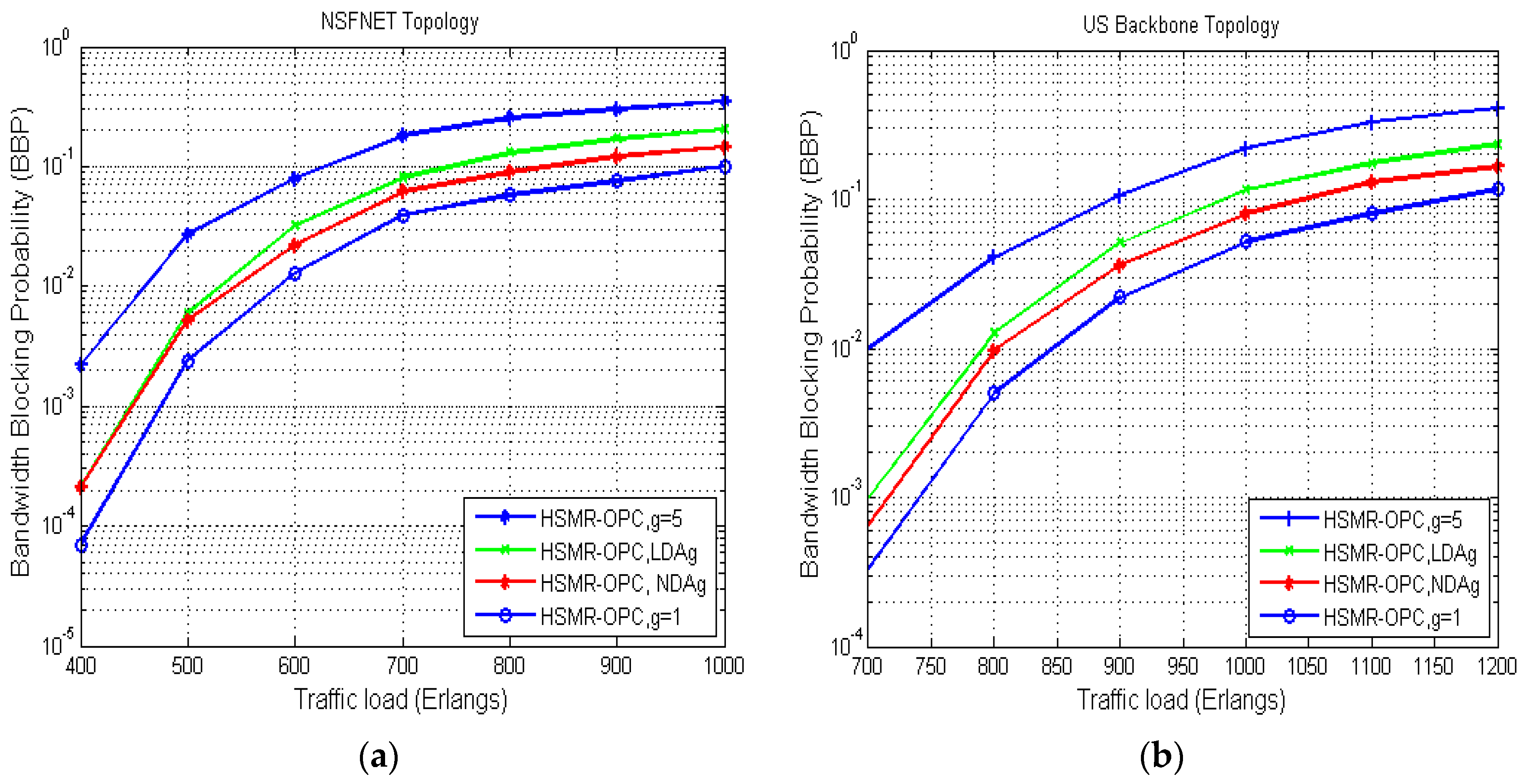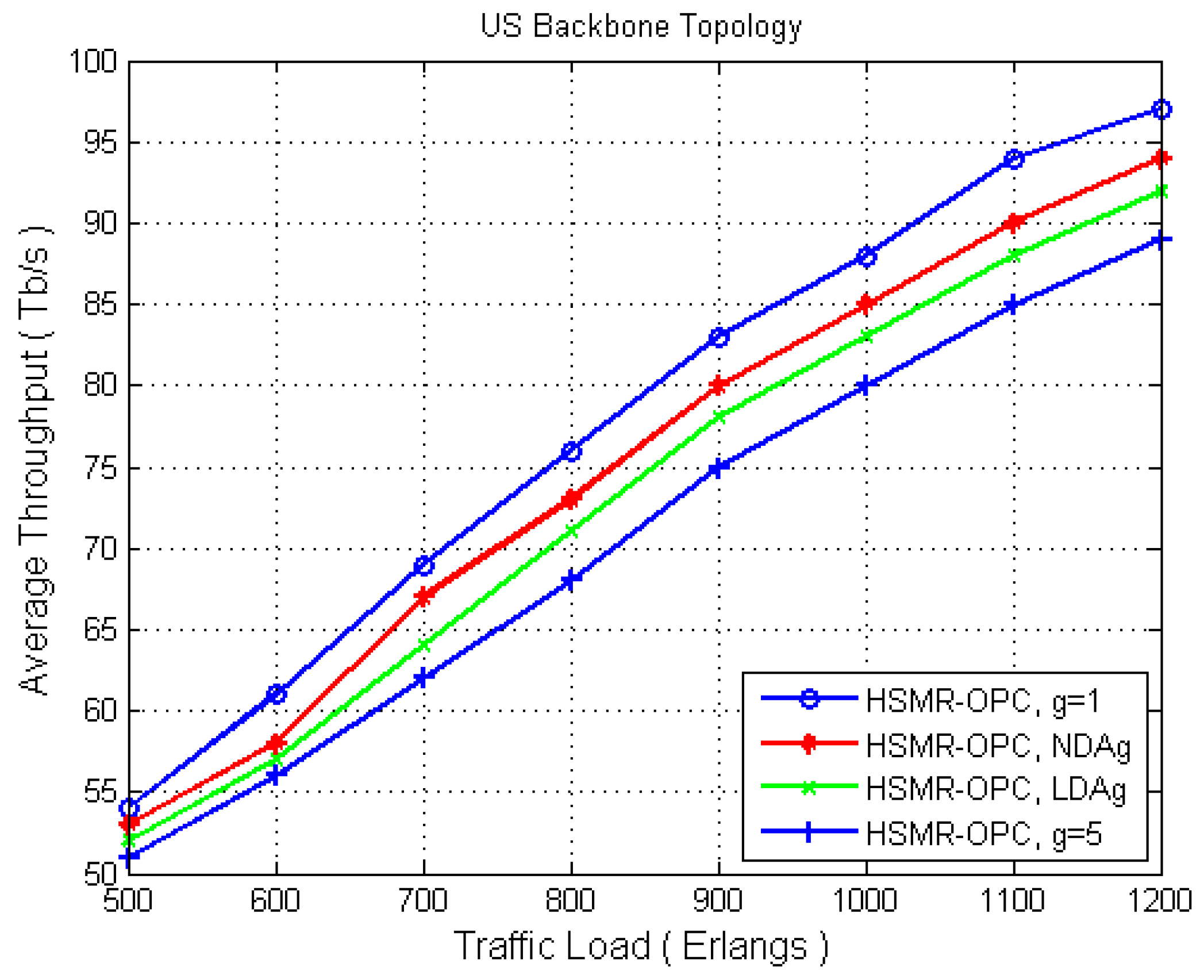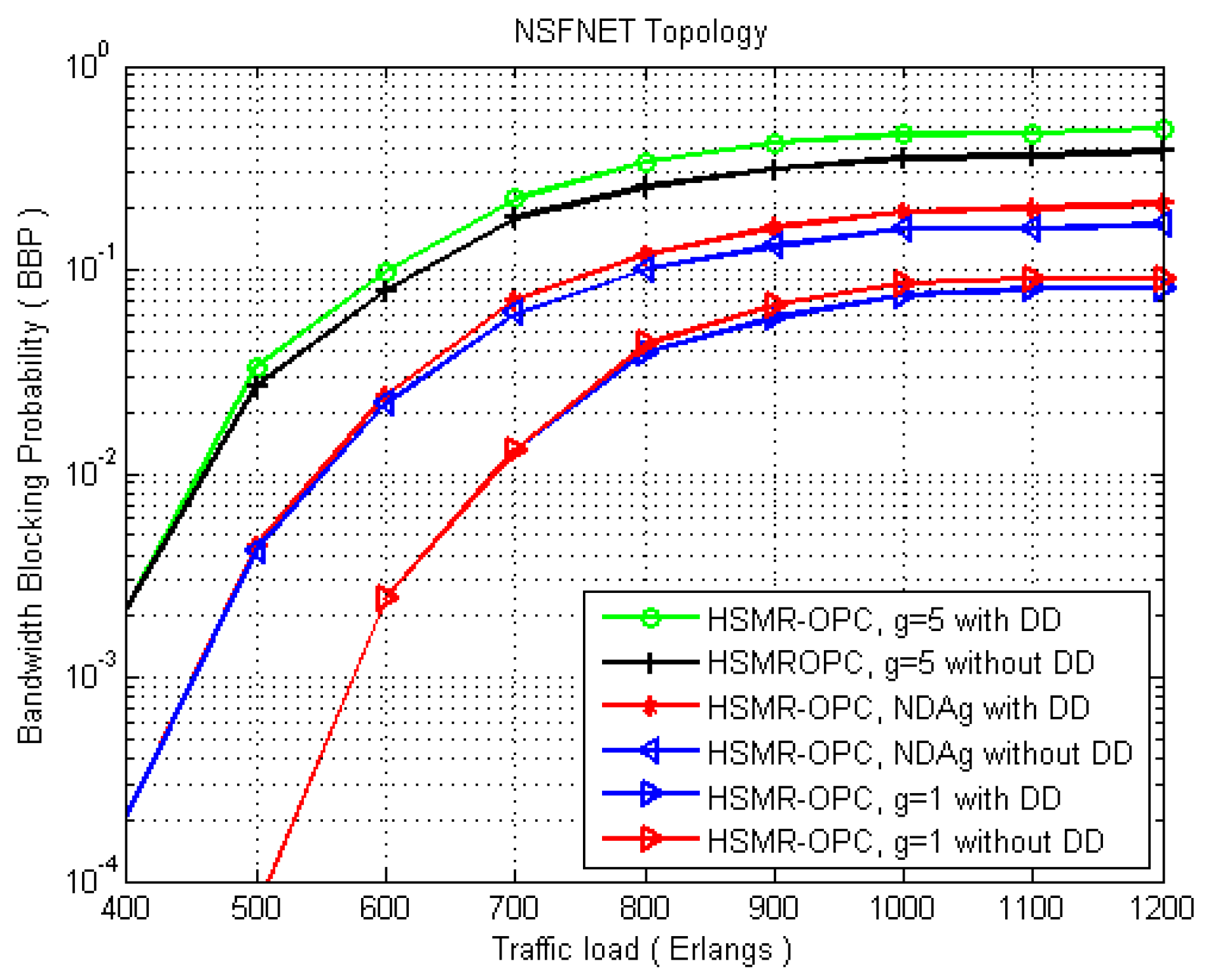Minimizing Blocking Probability in Elastic Optical Networks by Varying the Bandwidth Granularity Based on Optical Path Fragmentation
Abstract
:1. Introduction
2. Dynamic Minimum Bandwidth Allocation Granularity and Fragmentation
2.1. Dynamic Minimum Bandwidth Allocation Granularity
2.2. Fragmentation
3. Proposed Mechanism
3.1. Dynamic BW Granularity Adaptation Mechanisms
3.2. Routing and Spectrum Allocation Constraints
3.2.1. Contiguousness of Spectrum Constraint
3.2.2. Continuity of Spectrum Constraint
3.2.3. Spectrum Non-Overlapping Constraint
3.2.4. Differential Delay Constraint
3.3. Network Topologies and Simulation Parameters of the Test Networks.
| Algorithm 1: Proposed Dynamic Adaptation Mechanism Using Online Path Computation. |
| Input: ), . Output: Single or HSMR for LR 1. receive the incoming service request ; 2. while the network is operational. Update to be a virtual auxiliary topology using (Equation (9)); 3. sort the calculated k-shortest routing path from s to d in G\ based on 4. for all candidate paths do 5. choose the modulation level Mi for real distance, using (Equation (8)); 6. calculate UE_path (γi) for each path using (Equation (4)); 7. determine the NDA(i) using (Equation (2)); 8. for all consecutive slots with size ≥ NDA(i) do 9. use (Equation (6)) to allocate capacity Ci as in (Equation (5)); 10. if C is satisfied in Equation (5) 11. break for-loops in step 4 and step 8; 12. end if 13. end for 14. end for 15. if then 16. assign the request as blocked request; 17. end if 18. end while |
| Algorithm 2: Multipath Assignment Under Differential Delay Adaptation Constraint. |
| Input: , and a differential delay threshold (τ) Output: All candidate paths that satisfy τ. Condition: no available single short path 1. while the network is operational do 2. for to K, do 3. sort all available paths in ascending order of 4. delay in new path set P 5. end for 6. for do 7. If , using (Equation (18)) then 8. as paths can be assigned 9. end if 10. end for 11. use (Equation (6)) to allocate capacity Ci as in (Equation (5)); 12. If 13. assign the request as blocked request 14. end if 15. end while |
| Algorithm 3: Proposed Dynamic Adaptation Mechanism Using Fixed Path Computation |
| Input: . Output: Single or HSMR for LR 1. for all that ask for service do 2. find k-shortest routing path and Implement a set of path P 3. end 4. while the network is operational. Update 5. sort the calculated k-shortest routing path from s to d based on ; 6. for all candidate paths do 7. choose the modulation level for real distance, using (Equation (8)); 8. calculate UE_path (γi) for each path using (Equation (4)); 9. determine the the NDA(i), using (Equation (2)); 10. for all consecutive slots with size ≥ NDA(i), do 11. use (Equation (5)) to allocate capacity as in (Equation (6)); 12. if C is satisfied in (Equation (5)) 13. break for-loops in step 4 and step 8; 14. end if 15. end for 16. end for 17. If then assign the request as blocked request; 18. end if 19. end while |
4. Validation and Numerical Simulation Results
5. Conclusions
Author Contributions
Conflicts of Interest
References
- Willner, A.; Li, T.; Kaminow, I. Optical Fiber Telecommunications; Academic Press: Oxford, UK, 2013. [Google Scholar]
- Essiambre, R.; Kramer, G.; Winzer, P.J.; Foschini, G.J.; Goebel, B. Capacity Limits of Optical Fiber Networks. J. Light. Technol. 2010, 28, 662–701. [Google Scholar] [CrossRef]
- Berthold, J.; Saleh, A.A.M.; Blair, L.; Simmons, J.M. Optical Networking: Past, Present, and, Future. J. Light. Technol. 2008, 26, 1104–1118. [Google Scholar] [CrossRef]
- Gertel, O.; Jinno, M.; Loard, A.; Yoo, B. Elastic optical networking: A new dawn for the optical layer? IEEE Commun. Mag. 2012, 50, s12–s20. [Google Scholar] [CrossRef]
- Jinno, M.; Ohara, T.; Sone, Y.; Hirano, A.; Ishida, O.; Tomizawa, M. Introducing Elasticity and Adaptation into the Optical Domain Toward more Efficient and Scalable Optical Transport Networks. In Proceedings of the 2010 ITU-T Kaleidoscope: Beyond the Internet?—Innovations for Future Networks and Services, Pune, India, 13–15 December 2010; pp. 1–7. [Google Scholar]
- Jinno, M.; Takara, H.; Kozicki, B.; Tsukishima, Y.; Sone, Y.; Matsuoka, S. Spectrum-efficient and scalable elastic optical path network: Architecture, benefits, and enabling technologies. IEEE Commun. Mag. 2009, 47, 66–73. [Google Scholar]
- Hwang, T.; Yang, C.; Wu, G.; Li, S.; Li, G.Y. OFDM and Its Wireless Applications: A Survey. IEEE Trans. Veh. Technol. Soc. 2009, 58, 1673–1694. [Google Scholar] [CrossRef]
- Christodoulopoulo, K.; Tomkos, I.; Varvarigos, E. Elastic Bandwidth Allocation in Flexible OFDM-Based Optical Networks. J. Light. Technol. 2011, 29, 1354–1366. [Google Scholar] [CrossRef]
- Zhang, G.; DeLeenheer, M.; Morea, A.; Mukherjee, B. A Survey on OFDM-Based Elastic Core Optical Networking. IEEE Commun. Surv. Tutor. 2013, 15, 65–87. [Google Scholar] [CrossRef]
- Chatterjee, B.C.; Sarma, N.; Oki, E. Routing and Spectrum Allocation in Elastic Optical Networks: A Tutorial. IEEE Commun. Surv. Tutor. 2015, 17, 1776–1800. [Google Scholar] [CrossRef]
- Zang, H. WDM Mesh Networks: Management and Survivability; Kluwer Academic Publishers: Norwell, MA, USA, 2003. [Google Scholar]
- Christodoulopoulo, K.; Tomkos, I.; Varvarigos, E. Routing and Spectrum Allocation in OFDM-Based Optical Networks with Elastic Bandwidth Allocation. In Proceedings of the 2010 IEEE Global Telecommunications Conference GLOBECOM 2010, Miami, FL, USA, 6 –10 December 2010; pp. 1–6. [Google Scholar]
- Jinno, M.; Kozicki, B.; Takara, H.; Watanabe, A.; Sone, Y.; Tanaka, T.; Hirano, A. Distance-Adaptive Spectrum Resource Allocation in Spectrum-Sliced Elastic Optical Path Network. IEEE Commun. Mag. 2010, 48, 138–145. [Google Scholar] [CrossRef]
- Zhu, Z.; Lu, W.; Zhang, L.; Ansari, N. Dynamic Service Provisioning in Elastic Optical Networks with Hybrid Single-/Multiple-Path Routing. J. Light. Technol. 2013, 31, 15–22. [Google Scholar] [CrossRef]
- Khodashenas, P.S.; Comellas, J.; Spadaro, S.; Perelló, J.; Junyent, G. Using spectrum fragmentation to better allocate time-varying connections in elastic optical networks. IEEE/OSA J. Opt. Commun. Net. 2014, 6, 433–440. [Google Scholar] [CrossRef]
- Shi, J.W.; Zhu, Z.; Zhang, M.; Ansari, N. On the effect of Bandwidth Fragmentation on Blocking Probability in Elastic Optical Networks. IEEE Trans. Commun. 2013, 16, 2970–2978. [Google Scholar]
- Wen, K.; Yin, Y.; Geisler, D.J.; Chang, S.; Yoo, S.J.B. Dynamic on-demand Light path provisioning using spectral defragmentation in flexible bandwidth networks. In Proceedings of the 2011 37th European Conference and Exhibition on Optical Communication (ECOC), Geneva, Switzerland, 18–22 September 2011; pp. 1–3. [Google Scholar]
- Xi, W.; Zhang, Q.; Kim, I.; Palacharla, P.; Sekiya, M. Utilization Entropy for Assessing Resource Fragmentation in Optical Networks. In Proceedings of the 2012 and the National Fiber Optic Engineers Conference Optical Fiber Communication Conference and Exposition (OFC/NFOEC), Los Angeles, CA, USA, 4–8 March 2012; pp. 1–3. [Google Scholar]
- Zhang, M.; Lu, W.; Zhu, Z.; Yin, Y.; Yoo, S.J.B. Planning and provisioning of elastic O-OFDM networks with fragmentation- aware routing and spectrum assignment (RSA) algorithms. In Proceedings of the 2012 Asia Communications and Photonics Conference (ACP), Guangzhou, China, 7–10 November 2012; pp. 1–3. [Google Scholar]
- Al-Tarawneh, L.; Taebi, S. Dynamic adaptation of bandwidth granularity for multipath routing in elastic optical OFDM networks. In Proceedings of the 2015 Conference on Lasers and Electro-Optics (CLEO), San Jose, CA, USA, 10–15 May 2015; pp. 1–2. [Google Scholar]
- Al-Tarawneh, L.; Taebi, S. Linear dynamic adaptation of the BW granularity allocation for elastic optical OFDM networks. In Proceedings of the 2015 International Symposium on Performance Evaluation of Computer and Telecommunication Systems (SPECTS), Chicago, IL, USA, 26–29 July 2015; pp. 1–7. [Google Scholar]
- Tibuleac, S.; Filer, M. Transmission Impairments in DWDM Ne- works with Reconfigurable Optical Add-Drop Multiplexers. J. Light. Technol. 2013, 28, 557–598. [Google Scholar] [CrossRef]
- Huang, S.; Rai, S.; Mukherjee, B. Survivable Differential Delay Aware Multi-Service over SONET/SDH networks with virtual concatenation. In Proceedings of the Optical Fiber Communication and the National Fiber Optic Engineers Conference, Anaheim, CA, USA, 25–29 March 2007; pp. 25–29. [Google Scholar]
- Barlow, G. Traffic Delay in Ethernet over SONET/SDH. Available online: http://www.innocor.com/pdf_files/delay_inEos.pdf (accessed on 27 May 2016).
- Brady, J.F. Traffic Generation Concepts Random Arrivals. Available online: http://www.perfdynamics.com/Classes/Materials/BradyTraffic.pdf (accessed on 18 April 2016).
- Lu, W.; Zhou, X.; Zhang, M.; Zhu, Z. Dynamic Multi-Path Service Provisioning under Differential Delay Constraint in Elastic Optical Networks. IEEE Commun. Lett. 2013, 17, 158–161. [Google Scholar] [CrossRef]








| Simulation Parameters | |
|---|---|
| Frequency slots number per link, B | 300 slots |
| Frequency slot Bandwidth, BWslot | 12.5 GHz |
| Capacity of a frequency slot, Cslot | 12.5 GHz |
| Requested Capacity (C) | Range: 12.5–200 Gb/s |
| Slots number for guard-band, NGB | 1 |
| , bandwidth allocation granularity | 1–5 |
| Transmission Reach of: | Modulation format: |
| 9600 km, | |
| 4800 km, | |
| 2400 km, | |
| and 1200 km. | and, |
| Path candidates number, K | 5 |
| Propagation delay (r) | |
| DD: Differential Delay. |
| Traffic Load (Erlangs) | = 1 | NDA | = 5 |
|---|---|---|---|
| 400 | 0 | 0 | 0 |
| 500 | 0 | 4.76 | 23.7 |
| 600 | 0 | 5 | 24.05 |
| 700 | 0 | 12.7 | 23.33 |
| 800 | 10.3 | 19 | 23.37 |
| 900 | 13.75 | 20.69 | 23.53 |
| 1000 | 13.75 | 20.92 | 29.47 |
| 1100 | 14.67 | 21.47 | 29.72 |
| 1200 | 15.52 | 21.21 | 31.42 |
| Average (%) | 8 | 14 | 23 |
© 2017 by the authors. Licensee MDPI, Basel, Switzerland. This article is an open access article distributed under the terms and conditions of the Creative Commons Attribution (CC BY) license (http://creativecommons.org/licenses/by/4.0/).
Share and Cite
Al-Tarawneh, L.; Taebi, S. Minimizing Blocking Probability in Elastic Optical Networks by Varying the Bandwidth Granularity Based on Optical Path Fragmentation. Photonics 2017, 4, 20. https://doi.org/10.3390/photonics4020020
Al-Tarawneh L, Taebi S. Minimizing Blocking Probability in Elastic Optical Networks by Varying the Bandwidth Granularity Based on Optical Path Fragmentation. Photonics. 2017; 4(2):20. https://doi.org/10.3390/photonics4020020
Chicago/Turabian StyleAl-Tarawneh, Luae, and Sareh Taebi. 2017. "Minimizing Blocking Probability in Elastic Optical Networks by Varying the Bandwidth Granularity Based on Optical Path Fragmentation" Photonics 4, no. 2: 20. https://doi.org/10.3390/photonics4020020




